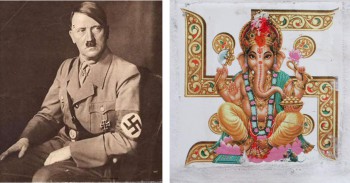10/26/2013
Why in India people burp when eating (or at any other point of time)
- Me: Hello, how are you today?
- My colleague: I’m not too good, I’ve got gas.
Oh Lord, gaaas??? How graceful! So for one thing my question was rhetorical and for another thing, gas??? Oh, this is gonna be a long, long day…
I wrote in August 2008 that while I "was peacefully walking in the street, a tiny old woman, passing by my side, let go of such a powerful burp that I would have been less shocked if she had called me a dirty bitch...".
Five years later, this topic is still big for me; for instance I recently had to inform one of my managers that if he wanted to promote one of his sales guys one day, he would have to start by asking him to stop burping all the time. This PIG makes me lose my appetite every time we eat together. He burps a good ten times during the meal. And not the small burps eh, no he goes all out, gives everything he has...
It is perhaps socially accepted (even appreciated) in India but when you work for an international company, you have to know the customs of your colleagues to avoid shocking your CEO visiting your country for a couple of days (and also losing all credit – yes I know, it’s sad but it is like this, we judge based on appearances...)
I am no one to give moral lessons to an Indian who would let out a huge fart in a train. But when my colleague blew my right ear with his burp, at a moment I was least expecting it (I was sitting in the car and on the phone), I forbade him very strongly to ever repeat this with me, ever again... So that we could share a good professional understanding. I do my best to adapt but I must admit, it is really hard when it comes to all these body noises...
It is actually probably the right thing to do and let the nature do, mind you but I just can't! Indians farts and burps a lot because 1. They don't restrain themselves, 2. They eat a lot of spicy food (which increases gases). Simple!
Here is what I had found on the burping theme at the time:
I asked myself “why am I such a prude?”, “why, even after 2 years, I still lose my appetite when an Indian guy burps loudly in the middle of a meal or why hearing someone clearing his throat in the restaurant sink gives me nausea? Why do I feel like slapping my Indian boss when he farts during a meeting?
appetite when an Indian guy burps loudly in the middle of a meal or why hearing someone clearing his throat in the restaurant sink gives me nausea? Why do I feel like slapping my Indian boss when he farts during a meeting?
Bah… I think that's CUL-TU-RAL... In Asia and the Middle East, a good eructation means that one has enjoyed the meal. In the Western world it is downright "yucky" (quote from the net which I fully support).
And yet, yet... These burping things have long been accepted in the West too.
For example, in the Roman empire:
"Burping at the table was a politeness justified by philosophers who thought that following the nature was the wisest thing to do." Pushing further this doctrine, the Emperor Claudius had taken an edict authorizing emitting other gaseous sounds. In his epigrams, Martial shows off to his hosts by calling with a snap of fingers the slave who brings them the urinal and helps them to use it. Finally, it was common to see, at the end of the cena, vomit soiling the precious mosaics of the floor. “ (1)
Then in the Middle-Age (2) (and you'll see that we are not far from the India of today!):
At the time, we ate very spicy food (and this causes gases (and Indians eat very spicy)); this was the era of spicy stews. (3)
Food is caught with the hands (which are regularly dipped in bowls of herbs to disinfect and perfume – fingerballs!). (4)
And people spat: "In the Middle Age, spitting was not only a custom, but also a natural need. The only restrictions that apply the courteous knights were to not spit on the table or across the table, but only under the table. » (5)
And finally at the Renaissance (I think this is the time burping started to become gross in Europe):
“Table manners appear in the nobility around 1530 following the publication of a book entitled Civilitas morum puerilium by Erasmus.” (6) Mundane meals became a sort of show where everyone shows off to be recognised for his rank. Catherine de Medici (1519-1589) brought the fork (with two teeth), fine earthenware and glassware, but we continued to eat with the fingers. At the table, the banks of the Middle-Age were replaced by individual seats, the towel became routine: it was very big to protect the flanges. On the tables, spices were easy to grab and they started serving meals with some order: it began with fruits, then gruels, the roasts or the grills, to finish by desserts. » (7)
Record:
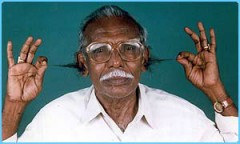 I did a small research and this is not an Indian who holds the record for the world loudest burp - they could, mind you, they already hold the record of longest hairs in the ears! (see post) - but a British, Hunnwhose burp reached 118.1 decibels (the equivalent of a chain saw in operation).
I did a small research and this is not an Indian who holds the record for the world loudest burp - they could, mind you, they already hold the record of longest hairs in the ears! (see post) - but a British, Hunnwhose burp reached 118.1 decibels (the equivalent of a chain saw in operation).
Quotes:
· "Why don't you burp or fart? Has this meal displeased you? “ Martin Luther.
· "Snobbery is a Champagne bubble that hesitates between fart and burp.” Serge Gainsbourg
· "Who does not burp nor fart is doomed to explode.": Erasmus.
(1) Source: emperors - Roman .net
(2) Article_Guidecasa.com_Le middle ages to table.pdf
(3) Source: guidecasa.com
(4) Source: peisme.blogspot.com
(5) Source: genebourgogne.org
(6) Source : Des bonnes manières.pdf
(7) Source : technoresto.org
(8) Source : Wikipedia
08:00 Posted in Why in India... | Permalink | Comments (0) | Tags: india, table manner, farting, burping, eructation, hair, hairs, hair in the ears, record, quotes | ![]() Facebook | |
Facebook | |
10/24/2013
Why in India we can see the Nazi cross everywhere?
The immediate answer here (with a bit of pride because many Indians greatly admire the leadership skills of the dictator – see here): Hitler copied the Hindu swastika and changed the sense of the branches...
In fact, it is a little more complicated than that!
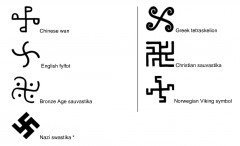 This cross (swastika), is a symbol of good fortune and well-being that has been used for over 3,000 years, in many cultures (it is the wan in China, the fylfot in England, the tetraskelion in Greece, the swastika in India and it is also present in the Amerindian, Japanese cultures etc). It was even sewn on the crests of the 45th American division during the first world war!
This cross (swastika), is a symbol of good fortune and well-being that has been used for over 3,000 years, in many cultures (it is the wan in China, the fylfot in England, the tetraskelion in Greece, the swastika in India and it is also present in the Amerindian, Japanese cultures etc). It was even sewn on the crests of the 45th American division during the first world war!
And in Germany, Hitler was not even the first one to claim ownership of the symbol...
In the 1870s, a German archaeologist, Heinrich Schliemann, found pieces of craftsmanship with swastikas on the alleged site of the ancient Troy in North Turkey. And since he had found similar pieces in Germany, he declared the swastika an ancient German symbol. The art of appropriation...
It was matching well the theories at the time according to which the Aryan people would be originating from Northern Europe and would have colonized almost everywhere, carrying their cross with them...
Let us draw the (unstable) context of the time where there was no real German identity. Indeed, it was only in 1871, after 70 years of conquest and formation of empires of the countries surrounding Germany, with Napoleon at the head of the procession, that the German Federal Empire was formed. In response to these disturbances, the German nationalist sentiment grew, with at its core a common hatred directed against Napoleon, his system and France.
It is in this context of the emergence of a national consciousness that Friedrich Schlegel, a 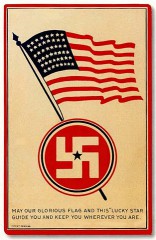 German scholar precursor and specialist of Indo-Europeanism, turned to the past and developed an interest in the origins of the Germans. He found links between indo-Iranians and German words: between “arya” (which refers to the Indo-Iranian people in their language) and “Ehre” (which means honor in German). He advanced the theory that in their language, the Indo-Europeans called themselves the “honorable people” (in Sanskrit Arya qualifies a noble man), and “Aryan” became synonymous with “Indo-European”. Through languages (and not ethnicity) were established ancestral links between Indians and Europeans. Schlegel placed the Aryan birthplace in India but gradually, scientists suggested different origins of the Aryan people (Central Asia, the Caspian Sea, then Southwest Europe). Finally it was decided that the Aryans had the physiotype of Northern Europeans. Quite far from history that places the ancient Indo-Iranian, Indo-European peoples in what is today Iran, Afghanistan and India. The Aryan had become the original man, of superior race. And he looked like the Germans! *
German scholar precursor and specialist of Indo-Europeanism, turned to the past and developed an interest in the origins of the Germans. He found links between indo-Iranians and German words: between “arya” (which refers to the Indo-Iranian people in their language) and “Ehre” (which means honor in German). He advanced the theory that in their language, the Indo-Europeans called themselves the “honorable people” (in Sanskrit Arya qualifies a noble man), and “Aryan” became synonymous with “Indo-European”. Through languages (and not ethnicity) were established ancestral links between Indians and Europeans. Schlegel placed the Aryan birthplace in India but gradually, scientists suggested different origins of the Aryan people (Central Asia, the Caspian Sea, then Southwest Europe). Finally it was decided that the Aryans had the physiotype of Northern Europeans. Quite far from history that places the ancient Indo-Iranian, Indo-European peoples in what is today Iran, Afghanistan and India. The Aryan had become the original man, of superior race. And he looked like the Germans! *
To get back to the hakenkreuze, at the beginning of the 20th century it symbolized German nationalism: for example the Wandervogel, a German youth movement around 1895 used it. Then finally Hitler described the new Nazi flag in Mein Kampf: “In red we see the social idea of the movement, in white the nationalistic idea, in the swastika the mission of the struggle for the victory of the Aryan man, and, by the same token, the victory of the idea of creative work, which as such always has been and always will be anti-Semitic.”
About the orientation of the branches, the two crosses have existed for thousands of years. The one that rotates clockwise (swastika) is a symbol that imitates the daily path of the sun. And the one that rotates the other way (sauvastika) generally represents night and black magic.
On top of this, maybe it is only me who has a vision problem but it looks that both the Hindu swastika and the Nazi swastika rotate in the same direction (the difference being a rotation of 45 degrees)...
In conclusion, Hitler has never set foot in India. I don’t think he really cared about it either.
Even if he has supported the “Free India Government” (or Azad Hind) formed by Indian nationalists in exile, with the help of Japan, whose aim was to kick the British out of India. In my opinion Hitler’s only interest here was to piss off his British enemies. He thus allowed Chandra Bose to recruit an army in his camps where at the time tens of thousands of Indians arrested by Rommel in North Africa were kept – 3,000 soldiers lent allegiance in 1942. But Bose had lost faith in the help of the Germany and left to the Japan (alone) and his soldiers ended up in the regular German army before being sent back to India at the end of the war.
* NB: The ideal of Hitler was not a Jew-free world but a world dominated by superior races. Which would naturally happen if he could eliminate inferior races and make the superior races reproduce (this is the theory of eugenics). He got people sterilized or simply got rid of them: the mentally challenged, the disabled, the blinds, and those suffering from genetic diseases. Then various races and peoples were included in the group: the old and sick, the deaf and the dumb, the “monkeys” (non-European breeds), the gypsies, the blacks. While the SS would spread their blessed seeds in special breeding farms where beautiful young blond girls were waiting for them.
Hitler also used the theory of evolution as a weapon against religion – which he hated. The moral virtues of religions (compassion, mercy, humility, love) didn’t really sticked well with his idea of a "merciless Aryan warrior."
In this context, it didn't take much to get the Jews under his radar, which he seemed to have a grudge against since his childhood. He also blamed them for the defeat of the First World War and the economic crisis which followed the stock market crash of 1929. He saw socialism, that he abhorred, as a Jewish conspiracy, since many socialist leaders in Germany and elsewhere were Jewish (Rosa Luxemburg, Leon Trotsky, Karl Marx etc.). And it wouldn’t arm his government to get funds to finance his delirium from the wealth of the Jews (see the fortunes of the Rothschild, or Bamberger who co-founded the Deutsche Bank, etc.).
http://www.cauchemardelamecreance.com/pages/2_4.php
http://history1900s.about.com/cs/swastika/a/swastikahistory.htmhttp://flagstamps.blogspot.in/2013/08/the-ancient-symbol-of-swastika-its-uses_5258.htmlhttp://www.freedomisknowledge.com/Meltingpot/topic3.html
http://hiphilangsci.NET/2013/07/24/rethinking-the-history-of-the-Aryan-paradigm/
http://www.TheFreeDictionary.com/Aryan
http://www.Napoleon.org/fr/salle_lecture/articles/files/allemagnesnapo_kerautret_nov2004.asp
08:00 Posted in Why in India... | Permalink | Comments (0) | Tags: india, swastika, sauvastika, hitler, racism, anti-semitism, wandervogel, mein kampf, flag, germany, napoleon, first world war, second world war, free india government, chandra bose, german federal empire, hakenkreuze, indo-european, aryan, jews, symbol | ![]() Facebook | |
Facebook | |
10/22/2013
Why in India there is a caste system?
After 7 years in India, I obviously wrote quite a bit on the subject (see below). I have sometimes been revolted against this system. I have accepted it. Ignored it. Forgotten it.
It is not so much this system – let us be realistic, every society is divided in social classes – but its rigidity that disturbs so much… Your caste (which you are born in) defines what you will do, eat, marry etc.
I have never really searched where this system comes from… 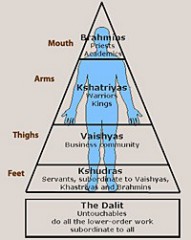
According to ancient Hindu books, human society was created from a body: the Brahmins would come from the head, the Kshatriyas from the hand, the Vaishias from the thighs and the Sudras from the feet. In some versions, the original body would be of a primeval giant, Purusha, sacrificed by the gods to create a human society; in others it would be Brahma.
All animated and inanimated things are believed to possess three qualities, in different proportions: Sattva, Rajas and Tamas. Brahmins would be loaded with Sattva qualities (which include wisdom, intelligence, honesty, goodness and other positive qualities); Kshatriyas and Vaishias with Rajas qualities (passion, pride, valour and other passionate qualities); Sudras with Tamas qualities (dullness, stupidity, lack of creativity and other negative qualities). Hence the different occupations that each people would occupy. And the different diets and different dosages of food they would need to develop their inherent qualities. For instance meat is considered Tamasic food but also Rajasic.
It seems likely to me that these two explanations were developed to support a system with social-historic roots. Which brings us back somewhere around 2000 years BC when the Harappan civilization of the Indus Valley started to decline and the Aryans (Indo-European speakers from Central Asia), a group of warrior nomads began to migrate. There is no agreement between scholars whether “the Aryans and Harappans mixed together and became peaceful, or the Aryans came in as a conquering people, became the ruling class, and instituted the caste system to maintain control”.
However, and this is my personal observation, the stratification of the society in India is clearly linked to the skin colour. The fairer the higher in caste, the smarter, the richer, the more beautiful. At least it is perceived like this. And it’s no new thing. One should see how a baby can stare at a white person. And I have met very few Indians who don’t have, somewhere, an inferiority – totally unjustified and difficult to understand for me – complex toward white skinned. And I don’t think it can only be the result of the British colonisation… Just read old Hindu religious stories: “there are many wars between the good Aryans and the dark skinned demons and devils”.
Somehow the organisation of the Aryans in three groups (the Rajayana which became the Kshatrias (warriors), the Brahmins (priests) and the Vaisias (farmers and craftsmen) , which is pretty logical and easy to adopt, spread on to the local society. Later on, “communities who professed non-polluting jobs were integrated in Sudra Varna and communities who professed polluting professions were made outcasts”.
 So it was convenient for the rules to keep the system that way – as it would be for any ruler in any society. Rules were strict and abided by. Religion (as Hinduism is mostly a canvas of superstitions) was also used to keep everyone on the right track in fear of retaliation. And what makes India different from other countries is that people don’t really rebel against the order of things, and neither does religion decline. They do at times – see how the Untouchable Ambedkar encouraged Hindus to convert to Buddhism in reaction to the caste system, and how such conversions of dalits still happen nowadays, for instance for the 50th anniversary of the leaders’s death* – but fundamentally the society remains the same…
So it was convenient for the rules to keep the system that way – as it would be for any ruler in any society. Rules were strict and abided by. Religion (as Hinduism is mostly a canvas of superstitions) was also used to keep everyone on the right track in fear of retaliation. And what makes India different from other countries is that people don’t really rebel against the order of things, and neither does religion decline. They do at times – see how the Untouchable Ambedkar encouraged Hindus to convert to Buddhism in reaction to the caste system, and how such conversions of dalits still happen nowadays, for instance for the 50th anniversary of the leaders’s death* – but fundamentally the society remains the same…
Is the caste system still present and visible in cities?
“Either it doesn’t really prevails in my world (personal and professional), either it is too subtle for me – at the same time I don’t really dig”.
However read my story of the fat superior Indian giving a lesson to a waiter:
(24/04/2013)
Do Indian people rebel against this system?
“In the countryside, the caste system prevails.
Read the story of Sampat Pal, a shepherdess who, with her Pink Sari gang, rebelled against the injustices inflicted to lower castes by higher castes or to women by men, against corruption and stealing of subsidised food, lands, jobs which the Government reserves for the poorest.”
(20/04/2013)
The issue of castes and quotas in today’s society
“The Indian Constitution prohibits discrimination based on caste.
That said it does not belong to the Government to abolish such a system because it is related to religion. As a matter of fact, the last census (2011) included a (optional) question about the caste.
Casteism is a pillar of Hinduism: "the fulfilment of one personal duty to the caste - and not a universal duty - and the system of reincarnation in a higher or lower caste as a reward for your good or bad actions are the two fundamental pillars of this religion until the final liberation and paradise.")
To fight this discrimination, the Government has implemented quotas for access to education, civil servant positions, political seats. There even has been an untouchable president (K. R. Narayanan).
The problem is that today it is all mixed up and ultimately these quotas are based on the social status (caste) of people but not on the merit or the income. And as low and out-castes form a majority, politicians are struggling to change this system...”
www.indiandacoit.com/archive/2013/04/22/about-casts-and-inequalities-in-india-the-big-picture.html
22/04/2013
What about the lower castes and outcastes? And how do Westerners see it?
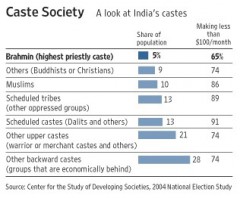 In India people referred to other compatriots as “uneducated” all the time. A term a bit shocking to a French. As the word “backward” to refer to a class of people in the lower castes.
In India people referred to other compatriots as “uneducated” all the time. A term a bit shocking to a French. As the word “backward” to refer to a class of people in the lower castes.
“According to the last census (source: http://www.censusindia.gov.in/2011census) « Intouchables » and the tribes represent 30% of the Hindu population / 24% of the Indian population. And if you add the ‘feet’ (kshudras or lower castes) you get 54% of the population.”
http://www.indiandacoit.com/archive/2011/04/14/and-you-what-s-your-little-name.html#more 04/05/2011
Marc Boulet wrote “In the skin of an Intouchable” – he basically learned Hindi perfectly, took drugs to get a tan and lived on the street as an Intouchable beggar for months…
“Westerners completely fall for it. They rightly fight racism and anti-Semitism but they see the caste system with a lot of indulgence and consider that it is part of the Indian cultural heritage, like the Tâj Mahal. They don’t get shocked, outraged, by the caste system; it is far away. And I also think that their benevolence comes from the fact they admire the brahman civilisation and they get disgusted by sweepers and other untouchables, altogether with beggars and lepers for whom they only think of a contemptuous charity. […] I am not scared of words anymore. The caste system is a segregationist system, just as Apartheid in South Africa. As revolting, as condemnable.”
http://www.indiandacoit.com/archive/2011/05/04/untouchables-again.html
14/04/2011
http://adaniel.tripod.com/origin.htm
http://www.thenagain.info/webchron/india/AryanMig.html
http://www.ambedkar.org/Babasaheb/Why.htm
08:00 Posted in Why in India... | Permalink | Comments (0) | Tags: india, ambedkar, caste, castes, cast system, religion, society, census, lower castes, outcasts, pink sari gang, backward, marc boulet, casteism, hinduism, sattva, rajas, tamas, aryans, fair, skin complexion, white | ![]() Facebook | |
Facebook | |
















